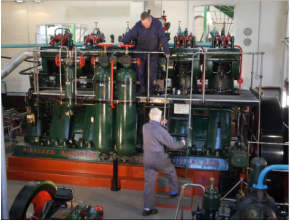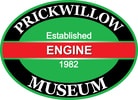The Mirrlees blast-injection system
explained by Patrick Cox, a Working Volunteer
|
The one thing a blast-injection engine needs to have, which sets it apart from other types of engine, is an air-compressor, capable of producing a constant supply of compressed air at a pressure of at least 800 p.s.i.
On a blast-injection engine, the fuel is pumped up to the fuel valve by a low pressure pump. The fuel valve is also under constant air pressure. When the piston in the cylinder is on the downward stroke, it draws in air from the atmosphere. This air is now trapped in the cylinder and, as the piston is now on the upward stroke, it compresses this air to about one-fourteenth of its original volume. The pressure in the cylinder will now be about 500 p.s.i. when the piston reaches the top. The temperature will be near 1,000 degrees Fahrenheit. At the top of the stroke, the needle valve (which is under constant air and fuel pressure) is lifted off its seat by a small cam on the camshaft, to allow the compressed-air at 800 p.s.i. to blow fuel through an atomizer in the fuel valve and thus spray a fuel mist into the cylinder. |

With a blast-injection engine, there is not an explosion as such as the fuel ignites but more a controlled burn which lasts approximately ten percent of the power stroke. Therefore the pressure in the cylinder when combustion occurs is not as great as that in a solid-injected engine. It was in 1893 that Dr. Rudolph Diesel obtained patents and Mirrlees-Watson were the first British company to be licensed to build this type of engine. It should be remembered that, two years earlier, Herbert Ackroyd Stuart (a Welshman) had invented the low-compression ‘hot-bulb’ engine. Dr. Diesel disappeared without trace during passage on the Antwerp to Harwich steam packet on 29 /30 September 1913. Back to Engineering |

